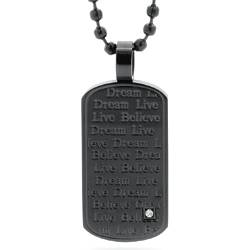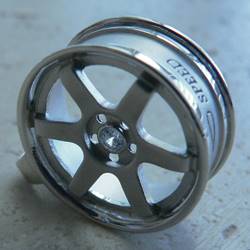Brave new man’s world
 5.3 k views | By Lorna Goodyer
5.3 k views | By Lorna Goodyer
Evolution in regional areas, the boom in mining, clever marketing and design have all helped turn men’s jewellery into a golden opportunity. Lorna Goodyer reports.
The mining industry could have a lot to answer for in Australia. Strapping young men are flocking to mineral-rich regional areas in search of high wages and returning home with their bank accounts bulging. You only have to look at the house prices in areas such as Perth to see the effect this newfound wealth is having. Equipped with their newly acquired city pads and prosperous jobs, these men are also taking their cash into stores. And more of them – here’s where this story gets really interesting – are walking into jewellery stores.
With a larger disposable income than ever before, these young men are one factor helping to fuel greater demand for, and acceptance of, men’s jewellery. Less conservative than previous generations, and inspired by a wealth of ideas and information found online, the modern Australian man (and not just the miners) is slowly but surely growing more accustomed to accessorising.
In fact, men’s jewellery sales are now thought to account for roughly 20 per cent of the $1.3 billion retail jewellery market, according to IBISWorld; this category grew 4.9 per cent in 2009-10 and is expected to increase another 5.2 per cent between 2010 and 2011. That’s $262 million compared with what less than 10 years ago was a very narrow, cufflink-oriented market.
And the margin to be made on popular men’s jewellery materials such as steel and tungsten carbide is persuasive for retailers and manufacturers alike, according to Nationwide merchandising manager Niven McArthur. “A lot of manufacturers are moving into these materials as they are inexpensive and allowing good margin on labour,” he says, revealing that Nationwide is witnessing a high sell-through rate in the $69 to $249 retail price category, with gross margins of 60-plus.
For some jewellers in regional towns, this trend has only recently taken off. Carol Schefe from Coomber Bros Jewellers in Roma, Queensland, is one retailer that has just seen a big jump in people looking specifically for less traditional men’s jewellery. “I would say that traditionally the men of the district were not jewellery wearers. The man on the land does a lot of physical work and jewellery would just get in the way. But due to the gas and mining industry coming into the area in a big way, I am finding a lot of younger men are coming into the store looking for good-looking jewellery; something different that is not just the norm.”
Opinion is mixed among suppliers as to whether this growth in regional sales is widespread. Darren Roberts, director of Australian supplier Cudworth Enterprises, which deals exclusively in men’s jewellery, is one distributor who has a lot of regional stockists and has seen a marked increase in the regional market. “It is a large growth in our business in the past few years,” he says. “Some of our best regional accounts perform better than some city accounts.”
Similarly, Rachael Abbott from Timesupply, which distributes French branded men’s range Guy Laroche in Australia, says times are changing. “Traditionally men from within city areas were more fashion conscious, however we have noticed that men from regional areas are now ready to experiment with different styles, and there is an increased demand from within regional areas for branded ranges,” she says, adding that branding is something Guy Laroche has found men – both in the city and in regional areas – latch on to: “Men like to feel confident in a brand that is internationally recognised and respected from other areas, such as fashion.”
Not every supplier has had the same experience with distribution though. Both Tuskc and RJ Scanlan, which supply branded men’s ranges, say there isn’t a big split between the performance of their brands in regional areas and the cities. RJ Scanlan director Stephen Brown points out that the traditional perception that men’s jewellery isn’t going to perform as well in regional areas could be a “self fulfilling prophecy” for jewellery stores. “In the jewellery trade there has been a wide held belief by some people that regional consumers prefer more basic products, perhaps are more macho and wouldn’t wear jewellery or are not prepared to spend as much on a jewellery item as their metropolitan cousins. Many stores then purchase products with this in mind so it becomes a self-fulfilling prophecy; if you don’t have it you can’t sell it,” he says.
If this is true, perhaps the industry itself is responsible for curtailing what has the potential to be a very lucrative market?
Leading Edge jeweller Theresa Mexsom is business manager for two stores in Western Australia – one in the provincial town of Albany 400km from Perth, and the other in Victoria Park just 10 minutes outside Perth’s CBD – so she can directly compare between the two locations. She says, “We sell a lot more male jewellery in the Perth store.” Mexsom attributes this to two persistent factors: more people in the city and a different mix of people. “It’s just more acceptable for a lot of the guys to wear quite ‘out there’ pieces of jewellery [in the city],” she says.
However, she believes the country boys are quickly catching up to their metropolitan counterparts. “Three years ago there was a big difference between what we bought for the Albany store and what we bought for Perth – now not so much. The regional areas are certainly catching up.”
Unlike Schefe in regional Queensland, Mexsom says mining has had little to do with the increase in demand at her regional store. Interestingly, she says wealthy miners have bolstered men’s jewellery sales in the city. “For us the mining is more prevalent for the city stores than the country. There’s a larger group in the city area that goes off to the mines. They do seven days on, seven days off.”

Tuskc
In Albany, she claims demand for men’s jewellery is being bolstered by the same behavioural changes affecting the whole industry – use of the internet. “The internet is having a big effect – [men] look at things online and then come in asking for them. Three years ago they weren’t as comfortable going online. The world is getting smaller.”
Helen Hagerty, operations director at Tuskc – which is stocked by both Mexsom and Schefe – agrees that the internet has been a game changer in regional areas, particularly for younger male shoppers: “The nature of Gen Y to keep themselves ‘in the know’ via the internet means regional stores are no longer so reliant on large shopping centres full of fashion branded stores to keep their customers informed on the latest trends,” she explains. With internet usage rising, it seems likely trends in regional areas will steadily fall into line with those in urban areas.
But although the rise of men’s jewellery in regional areas will help broaden demand for this category across the board, it should not be forgotten that the urban population in Australia far outweighs that of regional areas. According to IBISWorld, 89 per cent of Australia’s population lives in urban areas – and this figure is increasing at a slow but steady rate of 1.2 per cent a year. As Australians become more ‘urban’, men’s jewellery trends have mirrored this shift. Motifs that traditionally might have been associated with a more outdoors lifestyle – such as tribal, which is often present in sporting cultures – have taken a backseat to more industrial looks.
Tuskc, for one, has built a solid business in under two years by focusing on this increasing shift towards less traditional, ‘urban’ motifs and styles. As Hagerty says, “When you look at the trends on the street and the mix of materials and symbols featuring in men’s jewellery pieces, it is clear that designs are getting bolder and more daring.” Both Tuskc and RJ Scanlan’s TeNo brand have injected more colour into their ranges this year using PVD finishes and enamel. Tuskc has also introduced some cubic zirconia-set pieces, while Guy Laroche is using ceramics, ion plating as well as diamonds and some unusual stones like lapis lazuli. Indeed, IBISWorld highlighted men’s gemstone jewellery as a growth area in its November 2010 Watch and Jewellery Retailing in Australia report.
Perhaps the increasing use of gemstones in men’s jewellery signifies that as trends change men are becoming more comfortable again with ‘precious’ jewellery, which once upon a time men might have coveted but more recently has been perceived as solely for women? Cudworth, for example, also reveals that “sterling silver is becoming popular again”. At the Brisbane fair in March, Roberts attributed this to the fact that silver “is more prestigious”. He said, “There’s an elegance to silver, whereas with steel it’s a little bit more relaxed.”
That’s not to say the retail industry is necessarily about to see a big rise in shiny ‘bling’ pieces. Cudworth’s newest silver range, Cai, which proved popular at the Brisbane fair, is oxidised to give it a dull – rather than shiny – appearance. Likewise, Pendants Australia’s recent debut men’s collection of tribal-inspired jewellery has been cast in white phosphorous bronze plated with rhodium in order to reduce the shine of the pieces. Although Pendants Australia director Duncan Michaelis agrees that men are becoming more attracted to silver jewellery, he believes the metal can be “a bit too bright for men”. He explains, “Rhodium plating is not as bright. I think guys like to wear something a bit less blinding and tougher.”
Sydney-based image consultant Annalisa Armitage – who works with men to improve their fashion sense and personal identity – validates this view, telling her male clients to steer clear of high-shine pieces. “With casualwear [I advise] stick to earthy not bling. [Pick] materials such as wood and leather instead of gold and diamonds,” she says.
However, an increasingly urban population comes with other challenges for jewellery designers. Michaelis admits that his men’s collection is, in the main, “targeting a growing urban culture”, yet he recognises that there could be hurdles in that this growing city population is often working in offices and wearing suits: good for cufflink sales, but perhaps not so good for more adventurous men’s jewellery such as pendants and bracelets. Indeed, Armitage advises her male clients to accessorise with nothing but cufflinks when it comes to businesswear.
To overcome such obstacles, Michaelis believes marketing will be key and has launched a campaign called “Drop the tie”. He explains, “The idea behind the campaign was to say you don’t need to wear a tie. There’s a big trend towards a more casual working environment; [The campaign says] ‘Leave the suit at home and wear one of our pendants and carry a unique style with you’.”
So how else can jewellery designers, suppliers and retailers make themselves more appealing to men in order to cash in on this growing market? IBISWorld senior industry analyst Angela Kidson says that in terms of marketing, men are particularly susceptible to the use of brand ambassadors. “The marketing of jewellery to men is quite a different approach to how you would market to women,” she explains. Whereas women are looking for jewellery that is more individual, according to Kidson, men crave the endorsement that women don’t necessarily need to feel comfortable wearing jewellery.

Speed Jewellery
Speed Jewellery, which is due to launch its wheel motif collection into the Australian market on May 31, is one example of a company tapping into this concept of male validation through the use of an ambassador – in this case Australia’s last Formula 1 world champion Alan Jones. Founder Colin Burn believes this endorsement from a global male role model is guaranteed to help sell the brand. “Men are not as confident in wearing jewellery as women are,” he says. “Men are even more conscious sometimes than women – they would rather not wear [jewellery] than run the risk of making themselves look silly. Having a name representing your brand is a way of creating that reassurance.” Burn is so confident that Jones’ endorsement is the key to success that he says, “We’re going to sell it like Alan is making it; the whole brand is built around him.”
Another way Burn hopes to employ Jones’ endorsement is in getting men to make that all-important leap across the store threshold. After all, suppliers’ best efforts to get the product right and then market it in an appealing way may still fall flat if men can’t be persuaded to enter a jewellery store. “Part of our plan is to work with jewellery retailers and have Alan do signings at the stores – bringing men to the jewellery world,” Burn explains. “If retailers want to get men into their shops and are serious about selling men’s products, they need to bloke it up a bit.”
Jon Bird, founder of Sydney-based retail marketing and brand consultancy IdeaWorks, agrees that having a role model or spokesman behind your jewellery brand could work wonders with men. “In terms of how you bring the offer to life, it’s worth studying how the fragrance and skincare brands target men,” he advises, citing Dove’s ‘Men+Care’ strapline and decision to enlist Australian tennis champion Patrick Rafter as a brand role model as a good example of a brand successfully attracting men in a different retail category.
Like Burn, he too believes jewellery retailers that are serious about this growth market need to think long and hard about their store environment: “Make it clear that the jewellery is ‘for men’, use masculine imagery and colours.” Indeed, the feeling that jewellers could be doing more to attract men is not an uncommon concern – there is certainly a perception that men are more comfortable going into men’s fashion stores to buy jewellery than into more traditional jewellery stores. Brown says, “I think there is a reason why jewellery stores fail to attract men into their store and that is the perception that there are few products in the store that would appeal to them.”
However, Brown is optimistic that things are beginning to change; retailers – such as Schefe – are coming to understand that a half-hearted sales pitch won’t cut the mustard and are now investing in more ranges and dedicating window space to this high-potential category. Schefe, for one, is already seeing results: “I must say, since putting [Tuskc] there I have seen a lot of people stop and look and have had a lot walk in an ask to try pieces on and sold a few.”
To help jewellers better understand male consumers, Bird recommends deciding what type of man your store wants to attract. “Don’t just fixate on demographics, also consider psychographics – how he might think and behave. It’s a good exercise to paint a ‘pen picture’ of your target customer – give him a name, describe his life, his likes, dislikes, etc. And then put some thought into what we call the Customer Value Proposition – essentially, what distinctive product, service and retail environment is going to drag him across the lease line.”
Get that proposition right, and jewellery stores could find that the 50 per cent of the population that once thought such retail environments were ‘just for girls’ could be much more inclined to embrace their inner accessorising self within Australia’s jewellery stores.
who's driving the sale?
The answer is “men, wives, girlfriends and mothers”, if regional jewellery store owner Carol Schefe’s experience is anything to go by. However the general consensus is that women are still the main buyers.
Nationwide merchandising director Niven McArthur says data still shows 80 per cent of men’s jewellery sales are made to women, and attributes this to the belief that “women want their guy to look good and guys are hard to buy for”.
Cudworth Enterprise director Darren Roberts says this persistent trend could also have something to do with store environments. “Men are probably more comfortable going into menswear stores as everything in-store is suited to men. [Where as] jewellery stores mostly cater for women and in some stores have just a small men’s area.”
Yet, encouragingly, he and other suppliers reveal that more men are buying for themselves too – partly because they feel more confident stepping into what once would have been perceived as a female-only environment. Guy Laroche distributor Rachael Abbott from Timesupply explains, “We are finding that men are more confident and interested in making these choices themselves.”
RJ Scanlan director Stephen Brown insists jewellery stores shouldn’t give up. “Males often shop with females and once a couple is in the store the retailer gets an opportunity to make a sale to the male and a pitch to the female for future business,” he explains.
So paying a little more attention to the male shopper needn’t necessarily mean alienating your core market either.
Posted June 01, 2011